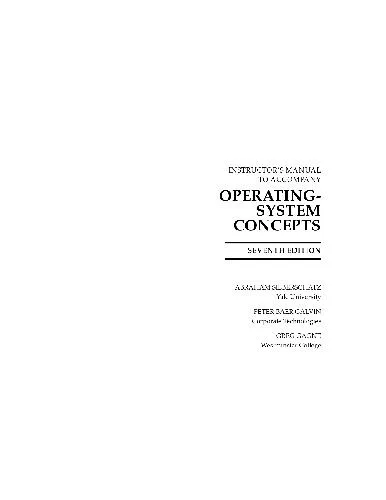Principles of Computer System Design: An Introduction
4.5
بر اساس نظر کاربران

شما میتونید سوالاتتون در باره کتاب رو از هوش مصنوعیش بعد از ورود بپرسید
هر دانلود یا پرسش از هوش مصنوعی 2 امتیاز لازم دارد، برای بدست آوردن امتیاز رایگان، به صفحه ی راهنمای امتیازات سر بزنید و یک سری کار ارزشمند انجام بدینکتاب های مرتبط:
معرفی کتاب "Principles of Computer System Design: An Introduction"
کتاب "Principles of Computer System Design: An Introduction" یکی از کتابهای اساسی و بنیادین در حوزه طراحی و تحلیل سیستمهای کامپیوتری است. نویسندگان این کتاب، جروم اچ. سالتزر و اِم. فرانس کاشوئک، با تجربه وسیع خود در این حوزه، مباحث کلیدی را به شکلی جامع و دقیق توضیح دادهاند.
خلاصه مفصل کتاب
کتاب به بررسی اصول اولیه طراحی سیستمهای کامپیوتری میپردازد و به دانشجویان و حرفهایهای این حوزه، دیدگاهی عمیق و ساختاریافته ارائه میدهد. این کتاب به دو بخش اصلی تقسیم شده است. بخش اول بر روی مبانی عمومی طراحی سیستمها تمرکز میکند و مباحثی چون کاهش پیچیدگی، استفاده از انتزاع، حفاظت دادهها، و حفظ تعادل بین هزینه و اجرا را پوشش میدهد. بخش دوم موضوعاتی پیشرفتهتر مانند تعامل بین اجزای سیستم، روشهای پیادهسازی پروتکلها، و مدیریت منابع سیستم را بررسی میکند.
نکات کلیدی کتاب
- اهمیت طراحی سیستمها بر اساس اصول پایدار و مستحکم.
- راهکارهای کاهش پیچیدگی سیستمها بدون از دست دادن عملکرد.
- نقش معماری سیستمی در ارتقاء عملکرد و کارآیی.
- استفاده از تکنیکهای انتزاع برای مدیریت بهتر دادهها.
- چگونگی تعامل اجزای مختلف یک سیستم به طور مؤثر.
جملات معروف از کتاب
"سیستمهای کارآمد تنها با طراحی دقیق و توجه به جزئیات ساخته میشوند."
"در طراحی هر سیستم، پیچیدگی دشمن اصلی است که باید با آن مقابله کرد."
چرا این کتاب مهم است؟
این کتاب نه تنها به دلیل پوشش کامل موضوعات نظری بلکه به خاطر نمونه های عملی و کاربردیاش اهمیت دارد. ساختار آموزشی و گام به گام کتاب، آن را به منبعی عالی برای یادگیری و تدریس تبدیل کرده است. برای دانشجویانی که قصد ورود به دنیای پیچیده طراحی سیستمهای کامپیوتری را دارند، این کتاب یک راهنمای ضروری است. همچنین برای مهندسان مجرب، مرجعی قابل اتکا برای به روز رسانی و تقویت دانش موجود خواهد بود.
Introduction to "Principles of Computer System Design: An Introduction"
Authored by Jerome H. Saltzer and M. Frans Kaashoek, "Principles of Computer System Design: An Introduction" is a comprehensive guide that delves into the fundamental concepts and principles underpinning the design of computer systems. This introductory text aims to impart a deep understanding of the design choices and trade-offs inherent in building robust, scalable, and efficient computer systems.
Detailed Summary of the Book
The book is structured to provide readers with a systematic exploration of computer system design principles. Saltzer and Kaashoek approach the subject methodically, dissecting system design into modular components and elucidating the intricate interplay between hardware, software, and system architecture.
Starting with an exploration of the core abstractions that define computer systems, the book progresses through topics such as naming and binding, the role of communication in system design, fault tolerance, and atomicity. It incorporates case studies and practical examples to illustrate how abstract concepts are applied in real-world systems, thus bridging the gap between theory and practice.
Readers are immersed in the practical aspects of designing system architectures and the physics of information flow, with careful attention to the subtleties of performance enhancements and optimization techniques. Each chapter builds upon the last, crafting a cohesive narrative that not only educates but also inspires new avenues of thought among system designers.
Key Takeaways
- Understanding the importance of modularity and abstraction in system design.
- Insight into the challenges and solutions related to naming and binding within computer systems.
- Approaches to enhancing system reliability through fault tolerance and redundancy.
- Techniques to achieve atomicity and ensure consistency in concurrent operations.
- Best practices for optimizing system performance without compromising stability or scalability.
Famous Quotes from the Book
"Complexity kills. It sucks the life out of developers, it makes products difficult to plan, build, and test."
"Every layer of abstraction has the potential to both illuminate and obscure."
"Successful systems are usually a healthy balance between clever insights and engineering trade-offs."
Why This Book Matters
The "Principles of Computer System Design: An Introduction" stands as an essential text for both students and practitioners of computer science and engineering. Its emphasis on principle-based learning equips readers with the tools needed to tackle contemporary challenges in system design and development.
By elucidating the core principles that define and drive computer systems, this book lays the foundation for innovative thinking and problem-solving. It is particularly valued for its clear presentation of complex ideas and its balance of theoretical rigor with practical application.
In a rapidly evolving technological landscape, understanding the principles that guide system design is critical for developing solutions that are not only effective but also sustainable. As such, this book is a vital resource for anyone committed to excellence in the engineering of computer systems.
دانلود رایگان مستقیم
شما میتونید سوالاتتون در باره کتاب رو از هوش مصنوعیش بعد از ورود بپرسید
دسترسی به کتابها از طریق پلتفرمهای قانونی و کتابخانههای عمومی نه تنها از حقوق نویسندگان و ناشران حمایت میکند، بلکه به پایداری فرهنگ کتابخوانی نیز کمک میرساند. پیش از دانلود، لحظهای به بررسی این گزینهها فکر کنید.
این کتاب رو در پلتفرم های دیگه ببینید
WorldCat به شما کمک میکنه تا کتاب ها رو در کتابخانه های سراسر دنیا پیدا کنید
امتیازها، نظرات تخصصی و صحبت ها درباره کتاب را در Goodreads ببینید
کتابهای کمیاب یا دست دوم را در AbeBooks پیدا کنید و بخرید
1755
بازدید4.5
امتیاز0
نظر98%
رضایتنظرات:
4.5
بر اساس 0 نظر کاربران
Questions & Answers
Ask questions about this book or help others by answering
No questions yet. Be the first to ask!








